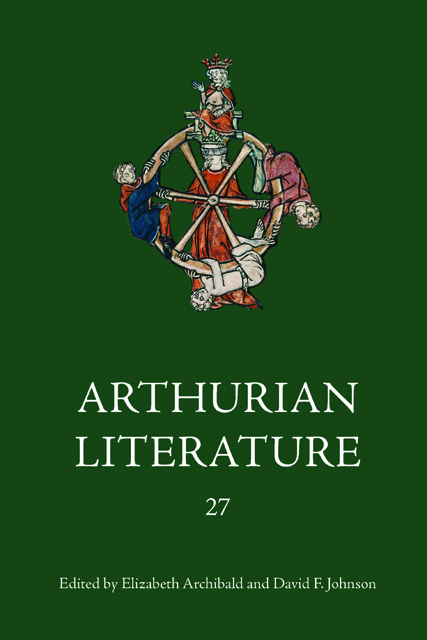Book contents
- Frontmatter
- Contents
- General Editors’ Foreword
- List of contributors
- I Commemoration in La Mort le roi Artu
- II ‘… “if indeed I go”’: Arthur’s Uncertain End in Malory and Tennyson
- III The Intruder at the Feast: Negotiating Boundaries in Medieval Insular Romance
- IV What Women Really Want: The Genesis of Chaucer’s Wife of Bath’s Tale
- V Monstrous Appetite and Belly Laughs: A Reconsideration of the Humour in The Weddyng of Syr Gawen and Dame Ragnell
- VI Speaking (of) Treason in Malory’s Morte Darthur
- VII Lancelot of the Laik: A Scottish Mirror for Princes
- VIII Prince Arthur’s Archers: Innovative Nostalgia in Early Modern Popular Chivalry
- Miscellaneous Endmatter
IV - What Women Really Want: The Genesis of Chaucer’s Wife of Bath’s Tale
Published online by Cambridge University Press: 18 February 2023
- Frontmatter
- Contents
- General Editors’ Foreword
- List of contributors
- I Commemoration in La Mort le roi Artu
- II ‘… “if indeed I go”’: Arthur’s Uncertain End in Malory and Tennyson
- III The Intruder at the Feast: Negotiating Boundaries in Medieval Insular Romance
- IV What Women Really Want: The Genesis of Chaucer’s Wife of Bath’s Tale
- V Monstrous Appetite and Belly Laughs: A Reconsideration of the Humour in The Weddyng of Syr Gawen and Dame Ragnell
- VI Speaking (of) Treason in Malory’s Morte Darthur
- VII Lancelot of the Laik: A Scottish Mirror for Princes
- VIII Prince Arthur’s Archers: Innovative Nostalgia in Early Modern Popular Chivalry
- Miscellaneous Endmatter
Summary
The analogues of Chaucer's Wife of Bath's Tale (WBT) were classified at the end of the nineteenth century by Clouston and Skeat, who accepted as an analogue any story that told how someone took on a monstrous form and recovered his or her original shape. The subject might be male or female or young or old, and might not even be human. He or she might have become a dragon, a snake, a crocodile, or a frog, been made so ugly as to seem of another species, or been turned into something spine-chillingly indistinct. They even included a story from Mandeville's Travels in which the victim is not disenchanted, because no hero can be found who dares to face the dragon-form that has been wished upon her. Not surprisingly, they concluded that ‘Legends similar to the tale of the Knight and the Loathly Lady seem to be of universal currency and of very ancient date.’
True though that was, it was not very useful. What are now accepted as the two major groups of analogues of WBT were identified shortly afterwards by George Maynadier. One group, which we may call the first-order analogues, comprises Gower's Tale of Florent (dated, like WBT itself, 1387+), The Wedding of Sir Gawain and Dame Ragnell (third quarter of the fifteenth century), and The Marriage of Sir Gawain (?midseventeenth century). All of them tell stories very like that of WBT. The hero's life depends on his discovering what women most desire. A repulsive hag tells him that women want sovereignty. That saves his life, but he has to marry her in return. On their wedding night, she persuades him to give her sovereignty in their marriage. That breaks an enchantment, and she becomes young and beautiful. This plot-line distinguishes WBT and the first-order analogues as a group from other disenchantment stories. In almost all such stories, for instance, the transformation is triggered by a kiss, an embrace, or some other kind of physical contact. In these four tales, it is brought about by a grant of sovereignty in what sounds like a legally binding oral contract. Maynadier very reasonably concluded that the four tales must derive from an original that contained the plot-features they all share.
- Type
- Chapter
- Information
- Arthurian Literature XXVII , pp. 59 - 86Publisher: Boydell & BrewerPrint publication year: 2010
- 1
- Cited by

